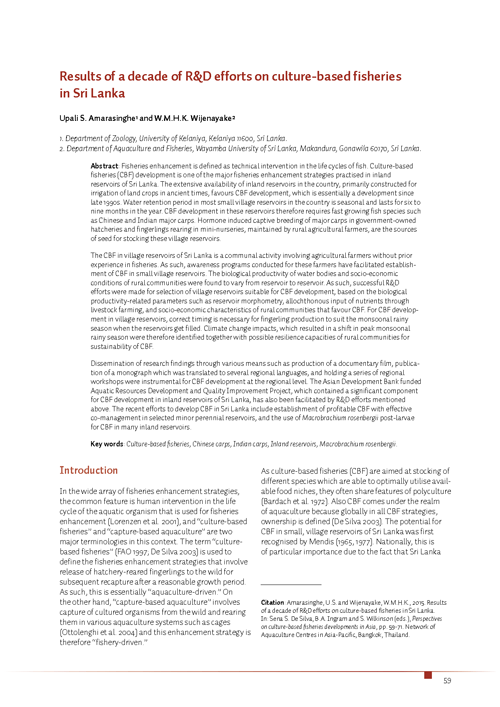Results of a decade of R&D efforts on culture-based fisheries in Sri Lanka
12 May 2015 | U. Amarasinghe, U. and W.M.H.K. Wijenayake | 1435 Downloads | .pdf | 1.72 MB | Culture-based fisheries, Freshwater finfish, Freshwater prawns, Inland aquaculture, Sri Lanka
Fisheries enhancement is defined as technical intervention in the life cycles of fish. Culture-based fisheries (CBF) development is one of the major fisheries enhancement strategies practised in inland reservoirs of Sri Lanka. The extensive availability of inland reservoirs in the country, primarily constructed for irrigation of land crops in ancient times, favours CBF development, which is essentially a development since late 1990s. Water retention period in most small village reservoirs in the country is seasonal and lasts for six to nine months in the year. CBF development in these reservoirs therefore requires fast growing fish species such as Chinese and Indian major carps. Hormone induced captive breeding of major carps in government-owned hatcheries and fingerlings rearing in mini-nurseries, maintained by rural agricultural farmers, are the sources of seed for stocking these village reservoirs.
The CBF in village reservoirs of Sri Lanka is a communal activity involving agricultural farmers without prior experience in fisheries. As such, awareness programs conducted for these farmers have facilitated establishment of CBF in small village reservoirs. The biological productivity of water bodies and socio-economic conditions of rural communities were found to vary from reservoir to reservoir. As such, successful R&D efforts were made for selection of village reservoirs suitable for CBF development, based on the biological productivity-related parameters such as reservoir morphometry, allochthonous input of nutrients through livestock farming, and socio-economic characteristics of rural communities that favour CBF. For CBF development in village reservoirs, correct timing is necessary for fingerling production to suit the monsoonal rainy season when the reservoirs get filled. Climate change impacts, which resulted in a shift in peak monsoonal rainy season were therefore identified together with possible resilience capacities of rural communities for sustainability of CBF.
Dissemination of research findings through various means such as production of a documentary film, publication of a monograph which was translated to several regional languages, and holding a series of regional workshops were instrumental for CBF development at the regional level. The Asian Development Bank funded Aquatic Resources Development and Quality Improvement Project, which contained a significant component for CBF development in inland reservoirs of Sri Lanka, has also been facilitated by R&D efforts mentioned above. The recent efforts to develop CBF in Sri Lanka include establishment of profitable CBF with effective co-management in selected minor perennial reservoirs, and the use of Macrobrachium rosenbergii post-larvae for CBF in many inland reservoirs.
Creative Commons Attribution.

